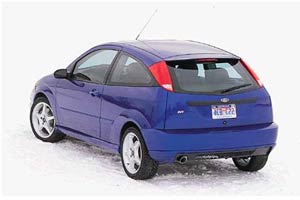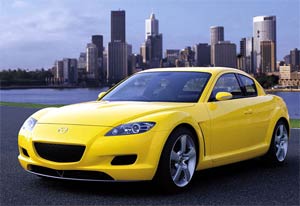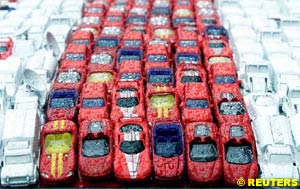

Automotive News and Reviews for the Petrolhead
Reuters Motoring Commentator
In this week's issue:
- Ford hit by new quality glitch
- Mazda gets top honours for RX-8
- Small wheels spin big money
Ford is urging owners of about 671,000 Focus compact sedans to bring the cars into local dealerships for replacement of a component linked to chronic engine stalling problems.
But Ford spokesman Glenn Ray said the sputtering engines, which the company is blaming on the corrosive effect of dirt or sludge buildup in a fuel delivery module designed in Europe, was not something the National Highway Traffic Safety Administration would officially record as a quality problem or recall.
"It's a product improvement programme. There is nothing fundamentally wrong with the quality of the fuel delivery module. It doesn't fail instantaneously or suddenly," Ray said.
"The root cause of the problem we've discovered in North America progressively over time is the variability and unpredictability of the gasoline-petrol standards in North America."
Ray said customers affected by the engine problem would get an extended 10-year vehicle warranty on the fuel replacement part and he stressed that no similar problems had been reported with 2002 and 2003 models of the Focus.
Mazda's RX-8 sports car has picked up the 'RJC Car of the Year' award in Japan, giving Mazda one of the industry's most coveted awards for the second straight year, Japan's No.5 auto maker says.
The 74 judges of the RJC (Automotive Researchers' and Journalists' Conference of Japan) also awarded Mazda's new "Renesis" rotary engine, which powers the RX-8, its Technology of the Year award.
After spending half of the 1990s in the red, Mazda, owned one-third by Ford, has been rebuilding itself by crafting a fresh brand identity with attractive and unique cars.
A day earlier, its sporty Mazda3/Axela compact was named runner-up in the 2004 European Car of the Year awards, while the Mazda6/Atenza sedan won the RJC's top award last year.
The RJC panel consists of automotive journalists, lawyers and university professors.
Boyhood dreams of toy cars that used to cost less than a pound each are now going for enough money to buy the real thing.
A Dodge Wreck truck that toy maker Lesney Matchbox put out in 1965 sold for $6,936.38 (4,080 pounds) on eBay on Monday. The usual price for this 3-inch die-cast model is about $15. The real truck costs $2,000 to $3,000.
In the nostalgic world of collecting, where every little nuance draws "oohs!" and "ahs!" that counts big time. Many rare Hot Wheels models are worth $8,000 to $10,000.
Still, that's nothing compared to the record $70,000-plus that Bruce Pascal, a commercial real-estate agent in Washington, shelled out for a Hot Wheels prototype in 2000.
"I believe Hot Wheels will grow as a hobby and what I paid will look small by comparison. I'm in it for the long haul," said the 42-year-old collector who doesn't plan to sell his Rear Loading Beach Bomb till he's in his 60s.
The pink "Rear Loading Beach Bomb" that Pascal bought is a van with a surfboard sticking out the back window, instead of the side as in the product that finally sold in stores in 1969.
This is the Holy Grail to collectors of Mattel's Hot Wheels brand, which features fantasy cars that have become part of the psyche of American boys' growing years.
"I can't tell you how exponential the enjoyment is of putting $5,000 into a die-cast car than it is to put $5,000 into a mutual fund," Pascal said. Counting the joys, he noted that his Beach Bomb is now on display in the Peterson Automotive Museum in Los Angeles, landing him a guest spot on "The Tonight Show with Jay Leno" on NBC-TV.
Jim Gallegos, owner of probably the world's largest die-cast car collection, says he has insured his more than 110,000 models for "seven figures." Not bad for toys that cost just 49 cents to 99 cents in the 1960s. Many new ones still retail for about $1, but thousands of older ones are regularly listed on eBay for much more.
"It's been a lot of fun," said Gallegos who, like most collectors, got hooked on die-cast cars as a child and still plays with them, along with his wife and son.
This pervasive social phenomenon began in 1953 when Lesney Products, a British partnership formed by ex-servicemen Leslie Smith and Rodney Smith, sold miniature vehicles in matchbox-sized boxes for 7.5 pence. In 1956 Matchbox toys -- realistic versions of actual vehicles -- debuted in the United States and dominated the market until 1968 when Mattel launched the Hot Wheels brand for fantasy cars.
Lesney introduced its Superfast line to compete, and subsequently added the Rola-Matic Miniatures, Convoy, Sky Busters, Battle Kings and Sea Kings brands. Through several acquisitions, Matchbox became a Mattel brand in 1997.
As die-cast cars grew from being just toys to hot collectibles, especially in the 1990s, many rival brands popped up to satisfy the demand. Clubs sprang up all over the world.
Prices shot up and are still climbing for rare, older models, such as those from Matchbox's Regular Wheels series from 1953-69.
Charlie Mack, who runs the Matchbox USA Club, recently sold a rare 1962 No. 30 six-wheel Matchbox crane in tan -- rather than the regular silver -- for $10,000 on eBay. A decade ago, it would have cost $600 to $700, estimated the author of "The Encyclopedia of Matchbox Toys".
A few months later, though, a less pristine sample of that tan crane sold for just $3,000.
"Condition matters," said Mark Curtis, who administers the member-run Matchbox Community Hall, the largest online message board on the brand. He warns that more fakes are showing up as prices continue to escalate for the most desirable models.
The market for new model cars has slowed in the past few years along with the U.S. economy. But manufacturers believe the innate drive among their customers may soon lead them out of the slump.
"It's nostalgia," said Mac Ragan, who manages the Johnny Lightning brand that Playing Mantis started in 1994. "We make cars that men from 35 to 60 years old remember when they were growing up. This is a way to bring them back to happier times in childhood."
Written by Richard Chang
![]() Ford hit by new quality glitch
Ford hit by new quality glitch
 The cars affected, from the 2000 and 2001 model years and sold in Canada and Mexico as well as the United States, have already been subject to an embarrassing total of 10 recalls by U.S. federal safety regulators.
The cars affected, from the 2000 and 2001 model years and sold in Canada and Mexico as well as the United States, have already been subject to an embarrassing total of 10 recalls by U.S. federal safety regulators.
![]() Mazda gets top honours for RX-8
Mazda gets top honours for RX-8
 The four-door four-seater RX-8, launched this April, beat out runners-up Toyota Motor's new Prius hybrid sedan and Fuji Heavy Industries' Subaru Legacy, which won the Car of the Year award last week from a separate group.
The four-door four-seater RX-8, launched this April, beat out runners-up Toyota Motor's new Prius hybrid sedan and Fuji Heavy Industries' Subaru Legacy, which won the Car of the Year award last week from a separate group.
![]() Small Wheels Spin Big Money
Small Wheels Spin Big Money
 So why the big premium? The trademark BP green and yellow colours on the eBay item are reversed, and the toy has a rare grey hook instead of the common red one.
So why the big premium? The trademark BP green and yellow colours on the eBay item are reversed, and the toy has a rare grey hook instead of the common red one.
© 2007 autosport.com . This service is provided under the Atlas F1 terms and conditions.
|
Volume 9, Issue 48
Articles
F1 at a Crossroad
Should Engine Specs be Changed?
Sixteen Sundays, Part II
2004 Countdown Facts & Stats
Columns
On the Road
Elsewhere in Racing
The Weekly Grapevine
> Homepage |